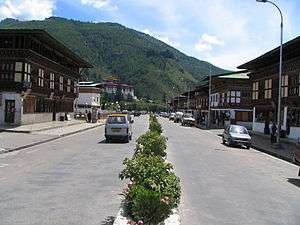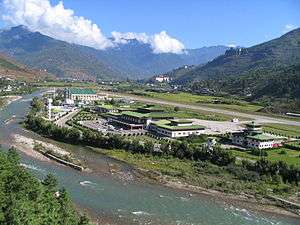Paro District
Paro District (Dzongkha: སྤ་རོ་རྫོང་ཁག་; Wylie: Spa-ro rdzong-khag) is a district (dzongkhag), valley, river and town (population 20,000) in Bhutan. It is one of the most historic valleys in Bhutan. Both trade goods and invading Tibetans came over the pass at the head of the valley, giving Paro the closest cultural connection with Tibet of any Bhutanese district. The dominant language in Paro is Dzongkha, the national language.
Paro district སྤ་རོ་རྫོང་ཁག | |
|---|---|
District | |
 Map of Paro District in Bhutan | |
| Country | Bhutan |
| Headquarters | Tshongdue |
| Area | |
| • Total | 1,293 km2 (499 sq mi) |
| Population (2017) | |
| • Total | 46,316 |
| • Density | 36/km2 (93/sq mi) |
| Time zone | UTC+6 (BTT) |
| HDI (2017) | 0.619[1] medium · 6th |
| Website | www |
Paro contains the only international airport in Bhutan, Paro Airport.
Geography


Paro District is bordered by Haa District to the west, Tibet to the north, Thimphu District to the east, and Chukha District to the south.
Administrative divisions
Environment
Northern Paro District (the gewogs of Doteng and Tsento) contains part of Jigme Dorji National Park and the biological corridor connecting it to Torsa Strict Nature Reserve in neighboring Haa District.[3]
Cultural sites
Important cultural sites of Paro include:
- Taktshang, or Tiger's Nest, the most famous monastery and ancient highlights for the people of Bhutan. It was founded as a meditating cave by the famous saint Guru Padmasambhava in the early 8th century upon subjugating a demon and forcing him to take an oath to be the local protector of the region towards the very end.
- Kyichu Lhakhang, which along with Jambay Lhakhang in central Bhutan is the oldest temple in Bhutan, dating to the 7th century.
- Drukgyel Dzong, at the upper end of the valley, built to protect against invading Tibetans, but in ruins since a fire in the 1950s.
- Paro Town, the single market town in the dzonghag which is booming (by Bhutanese standards) due to an influx of tourist dollars.
- Rinpung Dzong, also known as Paro Dzong, the massive fortress/monastery which is also the administrative center of the dzonkhag. Scenes from the movie Little Buddha were filmed in and around this dzong.
- The National Museum of Bhutan, where visitors can learn about the culture of Bhutan.
Paro Indian Military Base
Paro is the Indian Army's second military base outside its territory, the first one being Farkhor Air Base in Tajikistan where India also renovated but did not occupy the Ayni Air Base.[5]
See also
References
- "Sub-national HDI - Area Database - Global Data Lab". hdi.globaldatalab.org. Retrieved 2018-09-13.
- "Chiwogs in Paro" (PDF). Election Commission, Government of Bhutan. 2011. Archived from the original (PDF) on 2 October 2011. Retrieved 28 July 2011.
- "Parks of Bhutan". Bhutan Trust Fund for Environmental Conservation online. Bhutan Trust Fund. Archived from the original on 2 July 2011. Retrieved 26 March 2011.
- "Contact Us" . Druk Air. Retrieved on 8 October 2009. Archived September 1, 2009, at the Wayback Machine
- "What the US stance on F-16s means for Pakistan - The Express Tribune". tribune.com.pk. 4 May 2016. Retrieved 11 April 2018.
External links
| Wikimedia Commons has media related to Paro District. |
